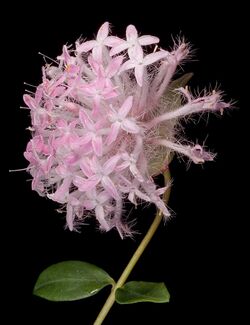Biology:Pimelea hispida
| Pimelea hispida | |
|---|---|

| |
| Scientific classification | |
| Kingdom: | Plantae |
| Clade: | Tracheophytes |
| Clade: | Angiosperms |
| Clade: | Eudicots |
| Clade: | Rosids |
| Order: | Malvales |
| Family: | Thymelaeaceae |
| Genus: | Pimelea |
| Species: | P. hispida
|
| Binomial name | |
| Pimelea hispida R.Br.[1]
| |
| Synonyms[1] | |
| |
Pimelea hispida, commonly known as bristly pimelea,[2] is a species of flowering plant in the family Thymelaeaceae and is endemic to the southwest of Western Australia. It is an erect shrub with elliptic leaves and erect clusters of pink flowers surrounded by 4 green involucral bracts.
Description
Pimelea hispida is a shrub that typically grows to a height of 0.2–1.5 m (7.9 in–4 ft 11.1 in) with a single stem at ground level. The leaves are elliptic, 9–29 mm (0.35–1.14 in) long, 2–9 mm (0.079–0.354 in) wide on a petiole 1–2 mm (0.039–0.079 in) long. The flowers are pink, arranged in clusters on an erect peduncle 5–40 mm (0.20–1.57 in) long, each flower on a pedicel 0.4–1 mm (0.016–0.039 in) long. The clusters are surrounded by 4 involucral bracts that are 9–20 mm (0.35–0.79 in) long and 7–20 mm (0.28–0.79 in) wide and green with pink or yellow parts. The flower tube is 11–16 mm (0.43–0.63 in) long, the sepals 2.5–5 mm (0.098–0.197 in) long, and the stamens are usually longer than the sepals. Flowering occurs from September to December.[2][3][4]
Taxonomy
Pimelea hispida was first formally described in 1810 by Robert Brown in his book Prodromus Florae Novae Hollandiae et Insulae Van Diemen.[5][6] The specific epithet (hispida) means "with bristly hairs", referring to the flowers.[7]
Distribution and habitat
Bristly pimelea grows on winter-wet flats and on coastal sand hills and is found from Geographe Bay to Albany and in the Stirling Range, in the Esperance Plains, Jarrah Forest, Swan Coastal Plain and Warren bioregions of south-western Western Australia.[2][4]
Conservation status
This pimelea is list as "not threatened" by the Western Australian Government Department of Biodiversity, Conservation and Attractions.[2]
References
- ↑ 1.0 1.1 "Pimelea hispida". Australian Plant Census. https://biodiversity.org.au/nsl/services/apc-format/display/68391.
- ↑ 2.0 2.1 2.2 2.3 "Pimelea hispida". FloraBase. Western Australian Government Department of Parks and Wildlife. https://florabase.dpaw.wa.gov.au/browse/profile/5249.
- ↑ Rye, Barbara L. (1988). "A revision of Western Australian Thymelaeaceae.". Nuytsia 6 (2): 252–253. https://www.biodiversitylibrary.org/item/232337#page/30/mode/1up. Retrieved 27 December 2022.
- ↑ 4.0 4.1 Rye, Barbara L.. "Pimelea hispida". Flora of Australia. Australian Biological Resources Study, Department of Agriculture, Water and the Environment: Canberra. https://profiles.ala.org.au/opus/foa/profile/Pimelea%20hispida.
- ↑ "Pimelea hispida". APNI. https://id.biodiversity.org.au/instance/apni/477389. Retrieved 31 December 2022.
- ↑ Brown, Robert (1810). Prodromus florae Novae Hollandiae et insulae Van-Diemen, exhibens characteres plantarum quas annis 1802-1805. London: Typis R. Taylor et socii. p. 360. https://www.biodiversitylibrary.org/page/2954516#page/228/mode/1up. Retrieved 31 December 2022.
- ↑ Francis Aubie Sharr (2019). Western Australian Plant Names and their Meanings. Kardinya, Western Australia: Four Gables Press. p. 218. ISBN 9780958034180.
Wikidata ☰ Q17582323 entry
 |

